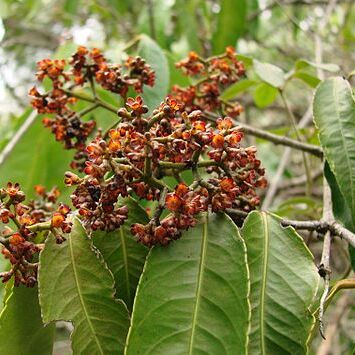Lianas or slender shrubs or trees usually with the upper branches scandent, glabrous throughout or essentially so, the branches and branchlets opposite; milky latex present. Leaves opposite, petiolate. Inflorescences axillary, pedunculate, thyrsoid, corymbose or cymose. Flowers hermaphrodite, small, pedicellate; sepals 5, narrowly imbricate, semiorbicular to deltoid or ovate, often erosulous or fim-briolate at the margins; petals 5, narrowly imbricate, usually rounded at the apex and entire, often thinly carnose; disc discontinuous, composed of 3 saccate, carnose, staminiferous lips confluent with the base of the ovary; stamens 3, the filaments often slightly enlarged at the apex, the anthers small, extrorsely nutant, trans-versely ellipsoid-, dehiscing by transversal, confluent, extrorse clefts; ovary 3-lobed, flattened at the truncate apex, 3-celled, the cells 2-or 4-ovulate, the ovules usually attached to the upper portion of the interior angles, collateral or superposed or in superposed pairs; stigmas 3, sessile, radiating, entire or emarginate or bilobed, op-posite the stamens and alternating with the cells of the ovary. Fruits drupaceous, small or medium-sized, subglobose, the pericarp coriaceous, the dissepiments soon evanescent; seeds 2-6, embedded in mucilaginous pulp, angulate, wingless.
More
Lianas, shrubs or small trees. Secondary veins widely ascending, tertiary veins usually parallel. Inflorescences axillary, thyrsoid, or several times dichotomously branched with minute bracts and bracteoles; pedicels short. Flowers small, in cymes at the end of ultimate branchlets; sepals 5, free, entire, erosulous or fimbriolate; petals 5, free, fleshy or slightly so, entire or erosulous; disk consisting of 3 (or 5 in C. anomalum) staminiferous pockets; stamens 3 (or 5), erect in the cavities between the disk and the ovary, filaments ligulate, anthers small, dehiscing by transverse, confluent clefts; ovary trigonous or pentagonous; locules 3 (or 5), ovules 2 or 4 per locule, collateral or superposed, stigmas adnate to the top of the ovary, their tips free, slightly projecting, entire or lobed, opposite the stamens. Fruits drupaceous, pericarp coriaceous; seeds embedded in mucilaginous pulp.

